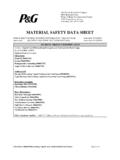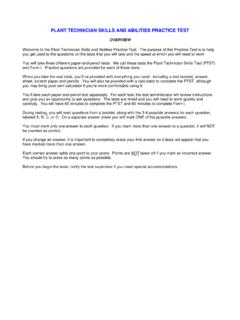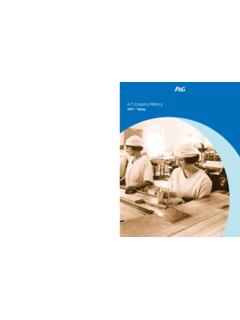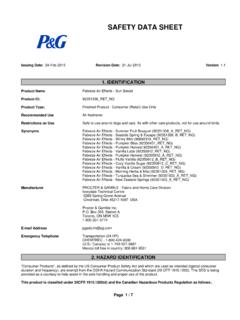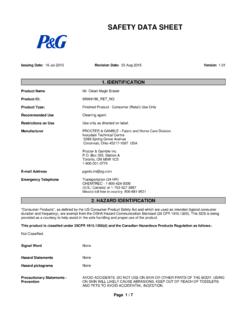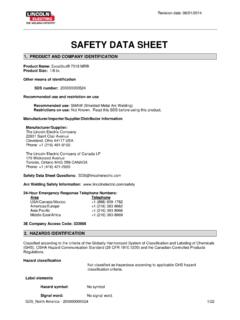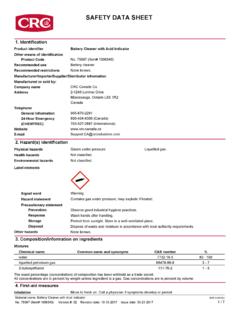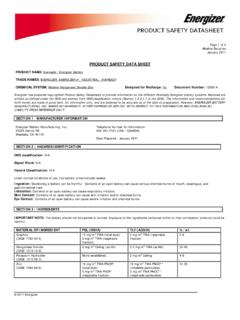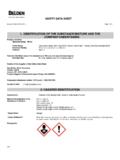Transcription of Product Safety Data Sheet (PSDS) - P&G
1 Product Safety data Sheet (PSDS) Lithium HPL EU Page 1 of 6 SECTION 1: IDENTIFICATION OF THE SUBSTANCE/PREPARATION AND OF THE COMPANY/UNDERTAKING Product Name: DURACELL LITHIUM MANGANESE DIOXIDE BATTERIES AND CELLS Product Use: Energy Source PSDS Date of Preparation: March 28, 2013 (replaces November 29, 2012); Reaffirmed/Updated April 11, 2014 Company Identification: EUROPEAN OFFICE US Office Procter& Gamble International Operations SA 47 route de Saint Georges, 1213 Petit Lancy, 1, Geneva, Telephone: +41 58 004 6111 P&G Duracell Berkshire Corporate Park Bethel, CT 06801 USA Telephone: 203 796 4000 SECTION 2: HAZARDS IDENTIFICATION These products are classified as Articles under REACH and are not subject to the requirements for Information in the Supply Chain ( Safety data Sheets and Labels). While batteries may release hazardous substances if damaged, this is not an intended release as defined under REACH.
2 Batteries are not classified as hazardous under the CLP. The following information is provided to assist in the safe use of our products. CAUTION: Battery can explode or leak if heated, disassembled, shorted, recharged, exposed to fire or high temperature or inserted incorrectly. Keep in original package until ready to use. Do not carry batteries loose in your pocket or purse. Keep batteries away from children. If swallowed, consult a physician at once. Under certain misuse conditions and by abusively opening the battery, exposed lithium can react with water or moisture in the air causing potential thermal burns or fire. Identity: Lithium Batteries and Cells (HPL) Description: Consumer Product Size/Designation Voltage IEC Designation Lithium Content(g)per Cell/Battery CR V3 3 CR V3 (Battery) 123, 123A, 2/3A, PL123 3 CR17345 (Cell) 223/223A 6 CR P2 (Battery) 245 6 2CR5 (Battery) CR2 3 CR17355 (Cell) 28L 6 2CR13252 .12g (Battery) 1/3N 3 CR1108 (Cell) DL1604 9 (Battery) Representative Product Image/ Packaging Lithium Coin EU Page 2 of 6 SECTION 3: COMPOSITION/INFORMATION ON INGREDIENTS Chemical Name CAS Number EINECS Number Amount 1,2 Dimethoxyethane* 110 71 4 203 794 9 5 10 % Carbon Black 1333 86 4 215 609 9 0 5% Ethylene Carbonate 96 49 1 202 510 0 0 5% Graphite 7782 42 5 231 955 3 0 5% Lithium 7439 93 2 231 102 5 1 5 % Lithium Perchlorate 7791 03 9 232 237 2 < % Lithium Trifluoromethane Sulfonate 33454 82 9 251 528 5 Manganese Dioxide 1313 13 9 215 202 6 15 45 % Propylene Carbonate 108 32 7 203 572 1 1 10 % *SVHC Substance per Candidate List Updated June 18, 2012 SECTION 4: FIRST AID MEASURES General Advice: The chemicals and metals in this Product are contained in a sealed can.
3 Exposure to the contents will not occur unless the battery leaks, is exposed to high temperatures or is mechanically, physically, or electrically abused. Eye Contact: If battery is leaking and material contacts the eye, flush thoroughly with copious amounts of running water for 30 minutes. Seek immediate medical advice. Skin Contact: If battery is leaking and material contacts the skin, remove any contaminated clothing and flush exposed skin with copious amounts of running water for at least 15 minutes. If irritation, injury or pain persists, seek medical advice. Inhaled: If battery is leaking, contents may be irritating to respiratory passages. Move to fresh air. If irritation persists, seek medical advice. Swallowed: If battery is swallowed seek immediate medical advice. Batteries lodged in the esophagus should be removed immediately since leakage, caustic burns and perforation can occur as soon as two hours after ingestion.
4 If mouth area irritation or burning has occurred, rinse the mouth and surrounding area with tepid water for at least 15 minutes. Do not give ipecac. Note to Physician: Published reports recommend removal from the esophagus be done endoscopically (under direct visualization). Batteries beyond the esophagus need not be retrieved unless there are signs of injury to the GI tract or a large diameter battery fails to pass the pylorus. If asymptomatic, follow up x rays are necessary only to confirm the passage of larger batteries. Confirmation by stool inspection is preferable under most circumstances. Potential leakage of less than 50 milligrams of dimethoxyethane and propylene carbonate. Dimethoxyethane rapidly evaporates. Do not give ipecac. SECTION 5: FIRE FIGHTING MEASURES Fire and Explosion Hazards: Batteries may burst and release hazardous decomposition products when exposed to a fire situation. Lithium Coin EU Page 3 of 6 Extinguishing Media: Use any extinguishing media that is appropriate for the surrounding fire.
5 Special Fire Fighting Procedures: Firefighters should wear positive pressure self contained breathing apparatus and full protective clothing. Fight fire from a distance or protected area. Cool fire exposed batteries to prevent rupture. Use caution when handling fire exposed containers (batteries may explode in heat of fire). Hazardous Combustion Products: Thermal degradation may produce hazardous fumes of lithium and manganese; oxides of carbon and other toxic by products. Detailed information on fighting a lithium metal battery fire can be found in Gide 138 of the US DOT Emergency Response Guide ( ). SECTION 6: ACCIDENTAL RELEASE MEASURES Notify Safety personnel of large spills. Irritating vapors and flammable may be released from leaking or ruptured batteries. Eliminate all ignition sources. Evacuate the area and allow the vapors to dissipate. Clean up personnel should wear appropriate protective clothing to avoid eye and skin contact and inhalation of vapors or fumes.
6 Increase ventilation. Carefully collect batteries and place in an appropriate container for disposal. Remove spilled liquid with absorbent and contain for disposal. SECTION 7: HANDLING AND STORAGE Avoid mechanical or electrical abuse. DO NOT short circuit or install incorrectly. Batteries may explode, pyrolize or vent if disassembled, crushed, recharged or exposed to high temperatures. Install batteries in accordance with equipment instructions. Replace all batteries in equipment at the same time. Do not carry batteries loose in a pocket or bag. Storage: Store batteries in a dry place at normal room temperature. SECTION 8: EXPOSURE CONTROLS/PERSONAL PROTECTION Exposure Limits: No exposure to the battery components should occur during normal use. Ventilation: No special ventilation is needed for normal use. Respiratory Protection: None required for normal use. Skin Protection: None required for normal use. Use butyl rubber gloves when handling leaking batteries.
7 Eye Protection: None required for normal use. Wear Safety goggles when handling leaking batteries. SECTION 9: PHYSICAL AND CHEMICAL PROPERTIES Appearance and Odor: Coin cells. Water Solubility: Insoluble Flash Point: 29 F ( 2 C) (1,2 Dimethoxyethane) SECTION 10: STABILITY AND REACTIVITY Stability: This Product is stable. Incompatibility/Conditions to Avoid: Contents are incompatible with strong oxidizing agents. Do not heat, crush, disassemble, short circuit or recharge. Lithium Coin EU Page 4 of 6 Hazardous Decomposition Products: Thermal decomposition may produce hazardous fumes of lithium and manganese; oxides of carbon and other toxic by products. Hazardous Polymerization: Will not occur SECTION 11: TOXICOLOGICAL INFORMATION Potential Health Effects: The chemicals and metals in this Product are contained in a sealed can. Exposure to the contents will not occur unless the battery leaks, is exposed to high temperatures or is mechanically, physically, or electrically abused.
8 Eye Contact: Contact with battery contents may cause irritation. Skin Contact: Contact with battery contents may cause irritation. Inhalation: Inhalation of vapors or fumes released due to heat or a large number of leaking batteries may cause respiratory and eye irritation. Ingestion: Seek immediate medical advice. Batteries lodged in the esophagus should be removed immediately since leakage, caustic burns and perforation can occur as soon as two hours after ingestion. Irritation to the internal/external mouth areas, may occur following exposure to a leaking battery. SECTION 12: ECOLOGICAL INFORMATION No ecotoxicity data is available. This Product is not expected to present an environmental hazard. SECTION 13: DISPOSAL INFORMATION Disposal should be in accordance with national and local regulations. Do not incinerate for disposal except for in a controlled incinerator. Duracell manganese dioxide lithium coin cell batteries are labeled in compliance with the EU Battery Directive 2006/66.
9 SECTION 14: TRANSPORT INFORMATION Emergency Phone Number: CHEMTREC 24 Hour Emergency Response Hotline +703 527 3887 (United States of America) Persons who prepare or offer lithium batteries for transport are required by regulation to be trained and certified. The information provided below is for informational purposes only. Lithium Coin EU Page 5 of 6 DOT Except for personal use, the shipment of lithium batteries aboard passenger aircraft is not allowed. Airline passengers may have non rechargeable lithium batteries for their equipment and a reasonable amount of spare non rechargeable lithium batteries for their equipment in their carry on luggage NOT in their checked baggage. For more information, air travelers should consult the US Department of Transportation (DOT) Safety Travel web site at Shipping packages containing non rechargeable lithium batteries must be labeled, regardless of size or number of batteries, with the following statement: PRIMARY LITHIUM BATTERIES FORBIDDEN FOR TRANSPORT ABOARD PASSENGER AIRCRAFT.
10 The transportation of lithium metal batteries is regulated as UN3090 by ICAO, IATA, IMO and US DOT. DURACELL lithium manganese dioxide batteries cells and batteries are not subject to the other provisions of the Dangerous Goods regulations as long as they are packaged and marked in accordance with the ICAO regulations. SECTION 15: REGULATORY INFORMATION EU BATTERY DIRECTIVE: These batteries comply with the Directive substance limits and labeling requirements. EU REACH REGISTRATION: These products are manufactured articles and not subject to REACH registration requirements. EU REACH SVHC: These products contains 1,2 dimethoxyethane (ethylene glycol dimethyl ether) which is listed on the Candidate List of Substances of Very High Concern. EU Labeling: Labeling is not required because batteries are classified as articles under the both REACH and the Dangerous Preparations Directive and as such are exempt from the requirement for labeling.


